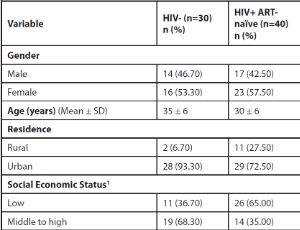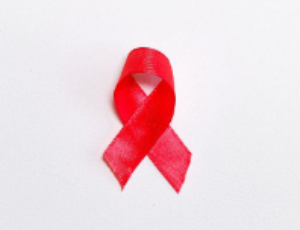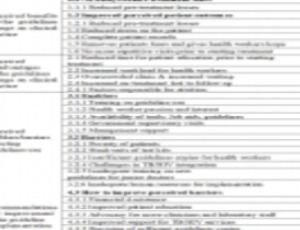Loading
Journal of AIDS and HIV Treatment
ISSN: 2688-7436
Featured Articles
Detection of Undiagnosed Elevated Cardiovascular Risk Biomarkers among HIV-Positive Patients on Antiretroviral Therapy (ART) in Kigali-City, Rwanda
Marcus Bushaku, Caleb Nyamwange, Arthur Kwena, Marc Twagirumukiza, Jean Nepo Utumatwishima, Regine Mugeni, Victor Davila-Roman, Aurore Nishimwe, Kenneth Schectman, W Todd Cade, Dominic Reeds, Eugene Mutimura
Similar to other African countries, life expectancy of people living with HIV infection has improved due to access to antiretroviral therapy (ART) in Rwanda. However, both HIV infection and use of ART are associated with cardiovascular disease (CVD) risks, due to adverse changes in some biomarkers, causing dyslipidemia and other metabolic imbalances. Biomarkers for CVD risk in HIV-infected individuals taking ART, has not been well characterized in Rwanda.
J AIDS HIV Treat, 2023, Volume 5, Issue 1 | DOI: 10.33696/AIDS.5.042
CCR5 Inhibitors and HIV-1 Infection
Olga S. Latinovic, Marvin Reitz, Alonso Heredia
Cellular components are attractive targets for antiviral therapy because they do not mutate as readily as do viral proteins do [1-3]. The identification of CCR5 as an HIV-1 coreceptor [4-7], facilitated by the discovery of the antiviral activities of CCR5 ligand ?-chemokines [8], resulted in the development of new viral entry inhibitors to block CCR5 binding, including both- small molecules and CCR5 antibodies
J AIDS HIV Treat, 2019, Volume 1, Issue 1, p1-5 | DOI: 10.33696/AIDS.1.001
From Silos to Solidarity: Case Study of a Patient-Centered, Integrative Approach to Opioid Tapering and Chronic Pain Mitigation in a Multidisciplinary AIDS Clinic
Sara D. Pullen, Marconi VC, del Rio C, Head C, Nimmo M, O’Neil J, Ziebart M
Chronic pain, defined as pain lasting longer than three months, is a significant public health burden and has been associated with depression, anxiety, poor quality of life and opioid use disorder (OUD).
J AIDS HIV Treat, 2021, Volume 3, Issue 1, p4-11 | DOI: 10.33696/AIDS.3.012
Pregnancy Outcomes in Pregnant Women with HIV on Tenofovir Disoproxil Fumarate (TDF) Compared to Tenofovir Alafenamide (TAF)
Matthew A. Thimm, Alison Livingston, Rosemary Ramroop, Ahizechukwu C. Eke
HIV infection in pregnancy continues to be of significant clinical and public health importance [1,2]. The current statistics published by the World Health Organization (WHO) demonstrate that 38 million people are living with HIV in 2019, and 1.1 million (85%) pregnant women living with HIV received antiretroviral therapy (ARVs) during pregnancy and postpartum.
J AIDS HIV Treat, 2022, Volume 4, Issue 1, p6-13 | DOI: 10.33696/AIDS.4.026
Potential Advantages of a Well-balanced Nutrition Regimen for People Living with Human Immunodeficiency Virus Type -1
Daniele Basta, Olga S. Latinovic, Yutaka Tagaya, Giovannino Silvestri
This review underscores the important role of nutrition in enhancing the management of Human Immunodeficiency Virus type 1 (HIV-1). Highlighting the efficacy of dietary interventions, including, the importance of omega-3 fatty acids, vitamins D and B-12, and the Mediterranean diet, we delineate how these beneficial nutritional strategies can improve the effectiveness of combined antiretroviral therapy (cART), mitigate its side effects, and ameliorate metabolic disorders in people living with HIV-1 (PLWH).
J AIDS HIV Treat, 2024, Volume 6, Issue 1, p11-27 | DOI: 10.33696/AIDS.6.048
Commentary on Lahiri et al. Weight and Body Mass Index Change After Switching to Integrase Inhibitors or Tenofovir Alafenamide Among Women Living with HIV
Francesca Macaluso, Deborah R. Gustafson
Among women living with HIV (WLWH), increases in body weight and body mass index (BMI, kg/m2) have been observed after switching to the antiretroviral therapies (ART) - Integrase Inhibitors (INSTI) and/or Tenofovir Alafenamide (TAF).
J AIDS HIV Treat, 2021, Volume 3, Issue 2, p21-23 | DOI: 10.33696/AIDS.3.016
Use of Humanized Mouse Models for Studying HIV-1 Infection, Pathogenesis and Persistence
Matthew Weichseldorfer, Alonso Heredia, Marvin Reitz, Joseph L. Bryant
Different humanized mouse models have been introduced to enable HIV-1 research in vivo, which has been made possible by the development of immunodeficient mouse strains.
J AIDS HIV Treat, 2020, Volume 2, Issue 1, p23-29 | DOI: 10.33696/AIDS.2.003
Health Workers’ Perspectives on the Outcomes, Enablers, and Barriers to the Implementation of HIV “Test and Treat” Guidelines in Abuja, Nigeria
Solomon Odafe, Kristen A. Stafford, Aliyu Gambo, Dennis Onotu, Mahesh Swaminathan, Ibrahim Dalhatu, Uzoma Ene, Oladipo Ademola, Ahmed Mukhtar, Ibrahim Ramat, Ehoche Akipu, Henry Debem, Andrew T. Boyd, Aboje Sunday, Bola Gobir, Man E. Charurat
HIV/AIDS continues to be a major public health disease accounting for 35 million deaths across the world. In 2016 alone, there were 1.8 million new HIV infections and 1 million deaths worldwide.
J AIDS HIV Treat, 2019, Volume 1, Issue 2, p33-45 | DOI: 10.33696/AIDS.1.007
Toward Personalized Medicine for HIV/AIDS
Carla M. Kumbale, Eberhard O. Voit
In 2019, approximately 38 million people were infected with HIV worldwide [1]. Although there is still no cure that successfully eradicates the disease, combination antiretroviral therapy (cART) has improved to a point where undetectable viral loads have become achievable and HIV carriers often live almost normal lives with very substantially increased average life expectancies compared to historical data.
J AIDS HIV Treat, 2021, Volume 3, Issue 2, p37-41 | DOI: 10.33696/AIDS.3.020
Older Versus Younger Men Who Have Sex with Men: Awareness of and Potential Barriers to the Use of Pre-Exposure Prophylaxis (PrEP) Medication to Prevent the Transmission of HIV
Hugh Klein, Thomas Alex Washington
Men who have sex with other men (MSM) comprise the single largest group of individuals contracting HIV in the United States, accounting for more than one-half of all new HIV diagnoses.
J AIDS HIV Treat, 2020, Volume 2, Issue 2, p42-50 | DOI: 10.33696/AIDS.2.006
Early Insights into COVID-19 in Persons Living with HIV and Cardiovascular Manifestations
Jelani K. Grant, Louis Vincent, Bertrand Ebner, Barry E. Hurwitz, Maria L. Alcaide, Claudia Martinez
At the end of 2019, a novel coronavirus was identified as the cause of a cluster of pneumonia cases in Wuhan, a city in the Hubei Province of China.
J AIDS HIV Treat, 2020, Volume 2, Issue 2, p68-74 | DOI: 10.33696/AIDS.2.010
About Scientific Archives
Scientific Archives is a global publisher initiated with the mission of ensuring equal opportunity for accessing science to research community all over the world. Spreading research findings with great relevance to all channels without any barrier is our goal. We want to overcome the challenges of Open Access with ensured quality and transparency.
